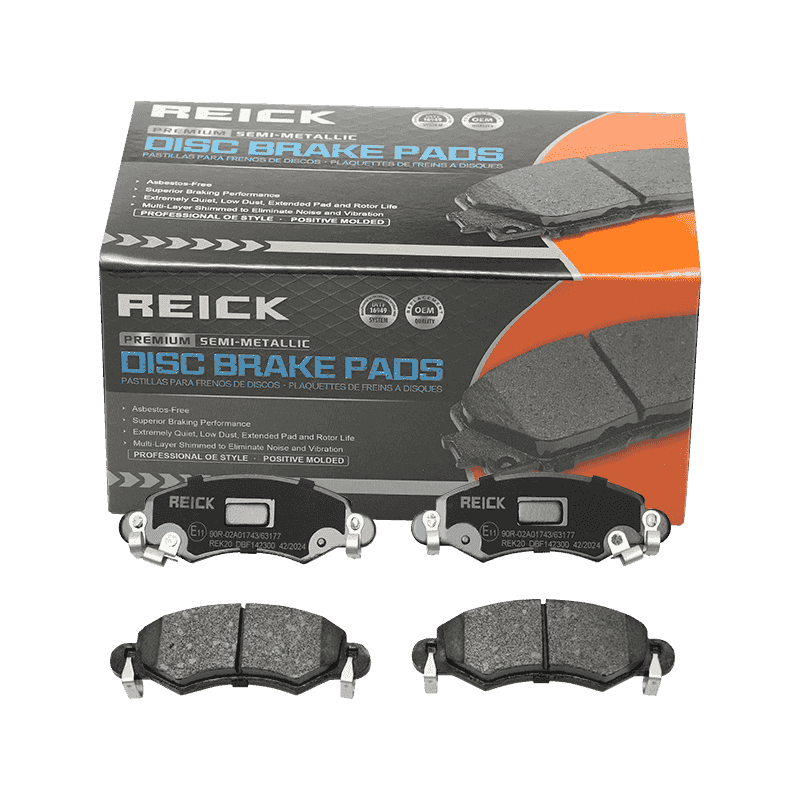 2025.11.07
2025.11.07
 Industry News
Industry News
When it comes to vehicle safety and performance, the choice of brake pads plays a crucial role. Among the various options available, Low Metal Brake Pads have gained attention for their balance between performance, durability, and comfort. Understanding their advantages can help vehicle owners make informed decisions, whether for everyday commuting, long-distance driving, or occasional spirited driving.
Before diving into the advantages, it’s helpful to understand what Low Metal Brake Pads are. These pads are typically made from a mixture of organic materials and a small percentage of metal fibers, usually less than 30%. The metal content helps improve heat transfer and friction performance, while the organic components help reduce noise and dust. This combination aims to offer a middle ground between traditional organic pads and fully metallic or semi-metallic pads.
One of the primary benefits of Low Metal Brake Pads is their consistent braking performance. The presence of metal fibers allows these pads to generate reliable friction across a wide range of temperatures. This results in better stopping power compared to purely organic pads, especially during moderate to heavy braking. For drivers who encounter varied road conditions, this consistency can provide greater confidence behind the wheel.
While fully metallic pads are known for their durability, they often produce more noise during braking. Low Metal Brake Pads, on the other hand, are designed to minimize squealing and vibration. The organic components in the pad absorb some of the energy that would otherwise create noise, offering a quieter driving experience. This makes them particularly suitable for daily commuting and urban driving, where brake noise can be a nuisance.
Excessive rotor wear can lead to costly repairs over time. Because Low Metal Brake Pads contain less metal than full-metal pads, they tend to be gentler on rotors. This means the rotor surface is less likely to develop grooves or wear unevenly, extending the life of both the pads and rotors. For drivers looking to reduce maintenance costs without sacrificing performance, this is a notable advantage.
Brake dust is a common complaint among car owners, as it can accumulate on wheels and affect appearance. While fully metallic pads often produce significant dust, Low Metal Brake Pads generate a moderate amount. The organic elements in the pad help control dust production, keeping wheels cleaner for longer periods and reducing the need for frequent cleaning.
Low Metal Brake Pads offer a versatile performance profile, making them suitable for a variety of driving conditions. Whether navigating stop-and-go traffic, cruising on highways, or tackling winding roads, these pads provide reliable friction and responsiveness. They strike a balance between durability and comfort, making them a practical choice for drivers who encounter mixed driving environments.
Brake fade occurs when pads and rotors overheat, reducing braking efficiency. The metal fibers in Low Metal Brake Pads enhance heat dissipation, helping maintain stable performance under moderate stress. While they may not match the extreme heat resistance of fully metallic pads, they perform better than purely organic pads in situations involving repeated braking, such as descending hills or city traffic with frequent stops.

Low Metal Brake Pads are often positioned between high-end ceramic pads and traditional organic pads in terms of cost. They provide many performance benefits of semi-metallic pads without the higher price point of premium options. For drivers seeking improved braking performance and moderate durability without significantly increasing maintenance expenses, Low Metal Brake Pads can be a cost-effective solution.
The combination of organic and metal components in these pads allows for smoother engagement and a more predictable brake pedal feel. Sudden grab or harsh braking sensations are minimized, making the driving experience more comfortable and controlled. This predictability can be particularly valuable in urban driving or during emergency braking situations.
Low Metal Brake Pads are designed to be compatible with a wide range of passenger vehicles, including sedans, SUVs, and light trucks. Their balanced material composition ensures they work well with standard rotors and braking systems, making them a practical replacement option for many drivers. This versatility eliminates concerns about compatibility that sometimes arise with high-performance or specialty pads.
While brake pads inevitably wear and release particles, Low Metal Brake Pads tend to have a slightly lower environmental impact compared to fully metallic options. Reduced metal content means fewer metallic particles are released into the environment. Additionally, their moderate dust production helps keep surrounding areas cleaner, contributing to a small but meaningful environmental benefit.
Despite their advantages, it’s important to understand the limitations of Low Metal Brake Pads. They may not offer the extreme heat resistance of full-metal pads for track use or heavy towing. However, for everyday driving, highway commuting, and occasional spirited driving, they provide a well-rounded solution. Regular inspection and maintenance, including monitoring pad thickness and rotor condition, will ensure optimal performance and longevity.
Low Metal Brake Pads offer a compelling combination of performance, durability, and comfort. They provide reliable braking, moderate rotor wear, reduced noise, and controlled dust production, making them suitable for a wide range of driving conditions. Their predictable pedal feel, cost-effectiveness, and compatibility with most vehicles further enhance their appeal. While they may not replace high-performance metallic pads in extreme scenarios, for everyday drivers, Low Metal Brake Pads present a practical and balanced choice that enhances both safety and driving experience.
By understanding the advantages of Low Metal Brake Pads, drivers can make informed decisions that improve braking performance, reduce maintenance costs, and ensure a quieter, more comfortable driving experience. Whether you are a daily commuter, weekend traveler, or occasional performance driver, these brake pads offer a reliable option that balances performance and practicality.